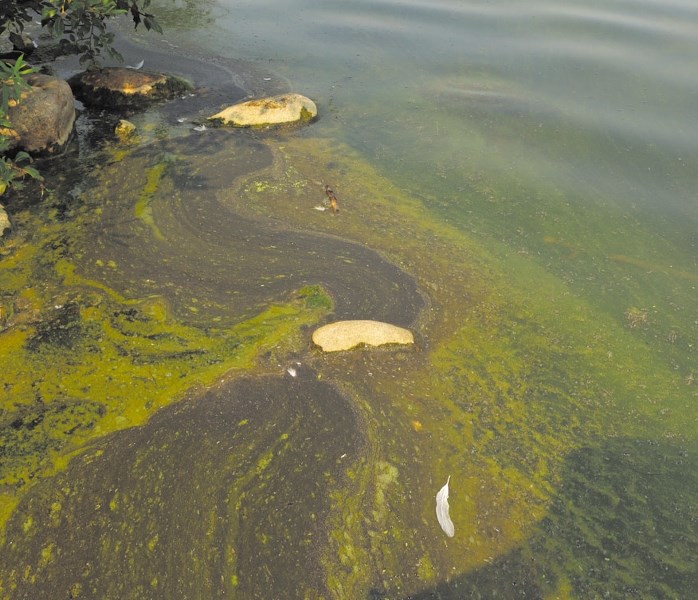One of the popular recreational lakes in the area might not be quite as attractive this summer.
Last week, a blue-green algae advisory was issued for Moose Lake by Alberta Health Services (AHS) after a bloom of the possibly toxic algae was spotted near the shores of the lake. Residents and visitors are being asked to avoid all contact with the blue-green algae and not go in the water or allow pets to go in the water in areas where a bloom is visible.
Whole fish or fish trimmings from Moose Lake shouldn't be fed to pets, and human consumption should also be limited as toxins can be stored in the liver of fish. Fish fillets are safe to eat.
“Algae are naturally occurring in fresh water bodies. Under certain meteorological conditions these algae multiply and become visible. Once they become visible, exposure to them through skin contact, ingestion, and inhalation could cause health concerns,” explained north zone medical office of health Dr. Gerhard Benade, noting that if the bloom isn't visible its not a concern for recreational purposes.
“Basically, it's a common sense thing. If you're on a beach and it's nice and clear, or in its usual condition, then it's safe to use at the moment.”
The condition of the lake can quickly change, as a bloom of blue-green algae will blow from one side of the lake to the other with a change in wind direction – making a different area of the lake unusable.
Contact with a blue-green algae bloom can cause redness in the eyes, irritation of the upper airways, and skin irritation.
If it's ingested, the toxin could possibly result in gastrointestinal upset, as well as fever and swollen lips. Symptoms usually appear within one to three hours and resolve in a couple of days.
If a human or animal is exposed to the algae, Benade advised that a fresh water shower and avoiding further exposure is the best step to take. When it's ingested, it's important to keep hydrated. If in doubt, have a physician assess the symptoms.
“We're basically just trying to educate people about what's happening, precautions they should take and how they can use the lake safely,” said Benade. “We do a risk assessment, submit samples, and do bacteriological testing – how many algae cells there area and whether there's evidence of the toxin or not, and the frequency of which people visit that lake, the likelihood that humans may be exposed. We also look at some of the agricultural influences in the area. Based on these we make a recommendation, so it is a precautionary advisory.”
For locals, hearing of a blue-green algae advisory for Moose Lake is far from a surprise. The popular waterbody has a history of being covered with the potentially toxic scum.
According to Moose Lake Watershed Society (MLWS) chair Kellie Nichiporik, pathology of the lake shows that there's been blue-green algae present for over 300 years.
“It is a big concern. Moose Lake is a very popular recreation lake so it does pose a concern for those who are wanting to use the lake for the summer.”
She explained, “Most lakes in Alberta are eutrophic or moving towards hyper-eutrophic status and as lakes age, they tend to get more productive, where the nutrient levels increase so the chances of having blue-green algae increases as well.”
To get a better picture of what's going on with nutrient levels in the lake, and understand what improvements can be made, the MLWS is engaging in an extensive study. In addition to the yearly tests done by the Alberta Lake Management Society, the local group received additional funding from their summer villages for testing.
Starting in June and running until September, samples will be drawn from the five bays of Moose Lake separately. This differs from the provincial study, which pulls out the samples together and takes an average for the whole lake.
“We can put this towards having a nutrient study done and that way we can find where our point sources are – if we're having issues in the lake, where they're more prevalent and then just target our future work and education on that,” said Nichiporik.
For now, the best course of action to help combat the persistent blue-green algae issues on Moose Lake is watershed management. Heavy development around the lake, as well as the removal of riparian plants to make shoreline, contributes to the lack of buffering capacity.
“It reduces the lake's ability to buffer and maintain a health ecosystem,” noted Nichiporik. “People need to monitor how much fertilizer they're putting on the lawn, as well as agricultural influences. Use the four ‘Rs' of nutrient application – right place, right time, right rate, and right source.”
Once their tests are wrapped up, the MLWS will be sending the samples off a laboratory for results, and producing a report with the findings.
Unfortunately, that won't help lake-users this summer. Benade expressed that while there is a chance the algae bloom will disappear, those heading down to Moose Lake will need to be on the look out no matter which part of the lake they're using.
“For a lake that tends to be shallow, there's some agricultural runoff, and it has a history of algae blooms in the past, at this stage in the season it will likely prevail for many weeks...The long and short of it is people should assess on a visit-by-visit basis.”



